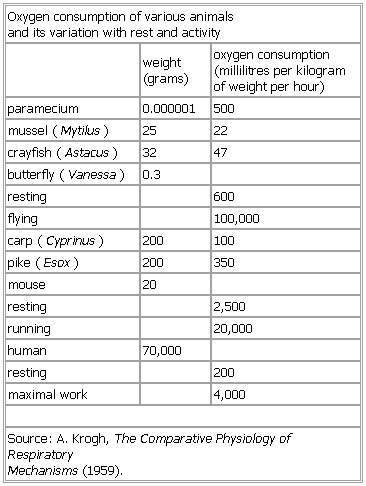Oxygen consumption of various animals and its variation with rest and activity
- Oxygen consumption of various animals and its variation with rest and activity
-
Oxygen consumption of various animals
and its variation with rest and activity
weight
oxygen consumption
(millilitres per kilogram
of weight per hour)
paramecium 0.000001 500
mussel (Mytilus) 25 22
crayfish (Astacus) 32 47
resting 600
flying 100,000
carp (Cyprinus) 200 100
mouse 20
resting 2,500
running 20,000
human 70,000
resting 200
maximal work 4,000
Source: A. Krogh, The Comparative Physiology of Respiratory
Mechanisms (1959).
See as table:
* * *
Universalium.
2010.
Look at other dictionaries:
respiration — respirational, adj. /res peuh ray sheuhn/, n. 1. the act of respiring; inhalation and exhalation of air; breathing. 2. Biol. a. the sum total of the physical and chemical processes in an organism by which oxygen is conveyed to tissues and cells,… … Universalium
Anthropology and Archaeology — ▪ 2009 Introduction Anthropology Among the key developments in 2008 in the field of physical anthropology was the discovery by a large interdisciplinary team of Spanish and American scientists in northern Spain of a partial mandible (lower… … Universalium
Climate change and agriculture — are interrelated processes, both of which take place on a global scale.[1] Global warming is projected to have significant impacts on conditions affecting agriculture, including temperature, carbon dioxide, glacial run off, precipitation and the… … Wikipedia
Life Sciences — ▪ 2009 Introduction Zoology In 2008 several zoological studies provided new insights into how species life history traits (such as the timing of reproduction or the length of life of adult individuals) are derived in part as responses to… … Universalium
Asia — /ay zheuh, ay sheuh/, n. a continent bounded by Europe and the Arctic, Pacific, and Indian oceans. 2,896,700,000; ab. 16,000,000 sq. mi. (41,440,000 sq. km). * * * I Largest continent on Earth. It is bounded by the Arctic Ocean, the Pacific Ocean … Universalium
respiration, human — ▪ physiology Introduction the process by which oxygen is taken up and carbon dioxide discharged. The design of the respiratory system The human gas exchanging organ, the lung, is located in the thorax, where its delicate tissues are… … Universalium
Earth Sciences — ▪ 2009 Introduction Geology and Geochemistry The theme of the 33rd International Geological Congress, which was held in Norway in August 2008, was “Earth System Science: Foundation for Sustainable Development.” It was attended by nearly… … Universalium
arts, East Asian — Introduction music and visual and performing arts of China, Korea, and Japan. The literatures of these countries are covered in the articles Chinese literature, Korean literature, and Japanese literature. Some studies of East Asia… … Universalium
Africa — /af ri keuh/, n. 1. a continent S of Europe and between the Atlantic and Indian oceans. 551,000,000; ab. 11,700,000 sq. mi. (30,303,000 sq. km). adj. 2. African. * * * I Second largest continent on Earth. It is bounded by the Mediterranean Sea,… … Universalium
Nobel Prizes — ▪ 2009 Introduction Prize for Peace The 2008 Nobel Prize for Peace was awarded to Martti Ahtisaari, former president (1994–2000) of Finland, for his work over more than 30 years in settling international disputes, many involving ethnic,… … Universalium

